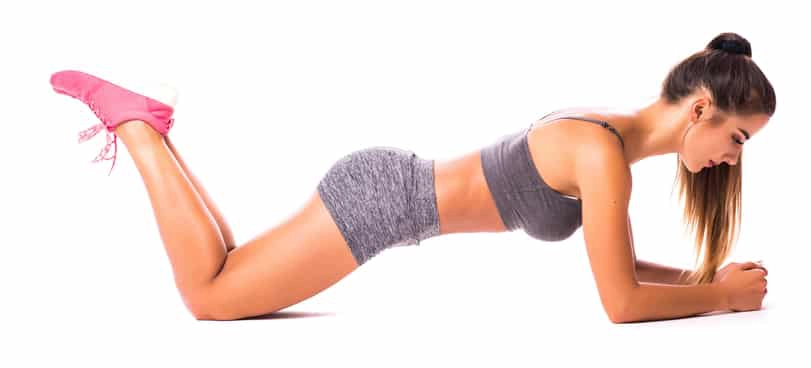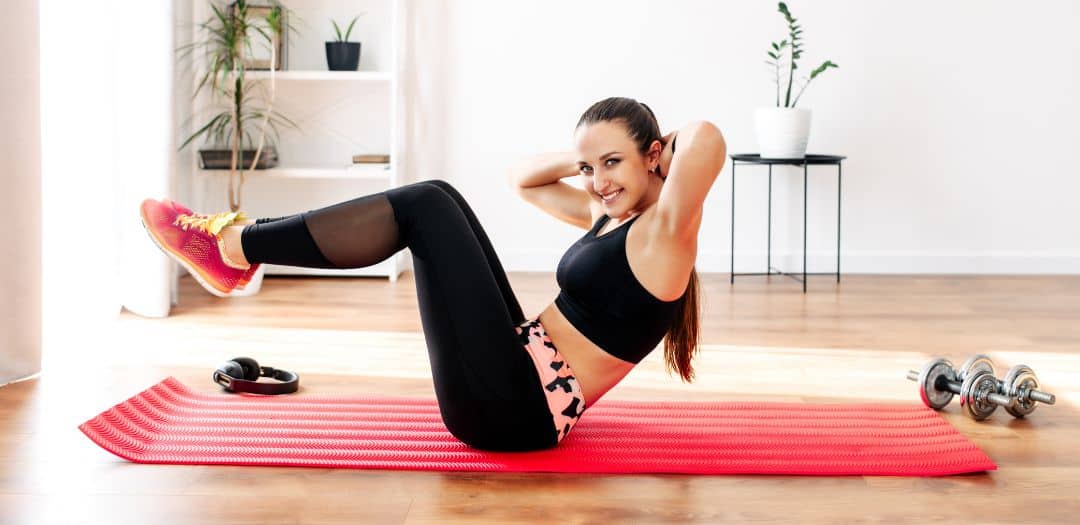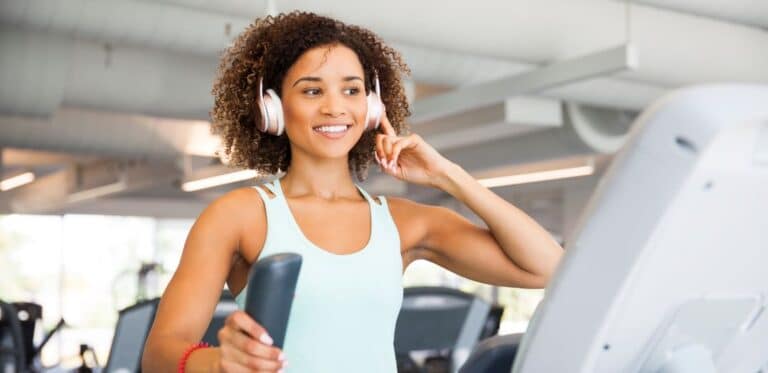5 Benefits of a Strong Core, Besides Six-Pack Abs
Thankfully, core strengthening exercises go way beyond crunches, and the benefits of strong abs involve a lot more than looks!
In this article, we’ll talk about which muscles make up your core, the benefits of a strong core, and finally, teach you some great core strengthening exercises for beginners.
What is Your Core?
Your “core” refers to all of the muscles that surround your torso and pelvis.
It’s the “muscular corset” that includes the front (abdominal), side (oblique), and lower back muscles in your body’s midsection.
Core strength helps us stand up straight, resist impact, and maintain balance.
These critical core muscles are located both close to the surface and deep inside your core.
While the rectus abdominis – the muscle that gives athletes that “six-pack” appearance – is the most visible of the group and often viewed as a major indicator of fitness progress, our other core muscles play equally important roles.
Benefits of a Strong Core
Lots of people work out their core to whittle their waist or tone their tummy, but the benefits of a strong core go way beyond six-pack abs.
A strong core is critical to health, whether you’re a professional athlete or a sedentary office worker.
The dozens of small and large muscles that wrap around our torso make it possible to carry groceries, pick up children, shovel snow and run – all without falling over.
Here are five functional benefits of strong abs and a strong core!
1) Easier Everyday Tasks
The first and most constant benefit of a strong core is that more core strength makes everyday activities easier. We use our core for almost every movement, all day long.
Here are just a few of the daily motions that require core strength:
- Rolling out of bed
- Twisting to grab milk out of the fridge
- Bending down to put on shoes
- Getting in and out of the car
- Sitting up straight at work
- Carrying bags/groceries
- Opening a heavy door
Very few of us get through a day without doing most, if not all, of these activities.
When your core is strong, you have more power to control the movement of your limbs and execute everyday tasks easily.
One of the biggest benefits of a strong core is being less exhausted at the end of the day. If little tasks take less effort, you have more energy for the big stuff.
2) Better Balance
Balance is also a big plus for improved core strength.
All of your core muscles work together to provide stability and keep you upright.
Why don’t we fall over when we walk on uneven terrain, miss a step, balance on one foot, or get hit in the arm?
Core strength. When you strengthen your core with regular exercise, stability and balance improve. So, a strong core reduces the risk of falling and improves overall balance.
3) Improved Posture
Display your slimmer body with confidence by maintaining a better posture.
Remember that your core includes not only your abs but also your back and side muscles.
One of the long-term benefits of a strong core is better posture and a lower risk of back injury! Keeping your back straight over time helps reduce wear and tear on your spine and makes breathing easier.
4) Stronger Back
More than 80% of Americans experience lower back pain at some point in their lives, but core strengthening exercises and weight loss can help.
In fact, core exercises are often prescribed as part of treatment even when back pain is already present. When these muscles are strong, it’s easier to keep your back straight and injury-free.
5) Fewer Injuries
Last but not least, when your core is strong, there’s less strain on your other muscles.
During sports (or when we jump, lift or swing in everyday life), we use our core to generate power. However, if your core is too weak to support the desired movement, your other muscles will try to compensate.
Unfortunately, since this adaption usually equates to bad form, the risk of injury increases.
Just like poor core strength can lead to injury, good core strength can also prevent injury. When your core muscles are strong, you’re more able to recover from stumbles and slips, which helps you avoid injury from falling.
Core Strengthening Exercises for Beginners

For decades, PE teachers and sports coaches have drilled crunches as the core exercise of choice. It wasn’t until recently that fitness and medical experts started pointing out the potential downsides of this popular move.
Our abdominal muscles can facilitate the action of a crunch/sit-up, but that’s not really what they’re designed for… And this repetitive movement isn’t particularly ideal for our backs either. So, while crunches can be part of your core workout, they should not be the only exercise.
Wondering what else to do? Here are five core strengthening exercises for beginners that can be adapted to be as easy or hard as you need. They may feel easy today, but we promise you’ll feel the burn tomorrow!
Reminder: Always check with your doctor before beginning a new workout routine, especially if you’ve been previously inactive or have any medical conditions that are affected or worsened by exercise.
Modified Plank
Plank is a great workout for all of your core muscles – front and back. For this modified plank, lay face-down and lift yourself up onto your elbows. Leave your knees down on the ground.
Make sure to keep your body straight from your shoulders to back to hips to knees; try not to let your hips sag down or arch up. Hold for 30 seconds.
Make it Easier: Hold for 10 seconds, rest for 10 seconds. Repeat this sequence three times.
Make it Harder: Straighten your legs and/or arms, so they’re fully extended (similar to a push-up position). As you get stronger, try to hold your plank for longer!
Modified Side Plank
Side plank helps work out your side core muscles and define your waist. This exercise is very similar to a forward plank, just rotated.
Turn your body ninety degrees, but try to keep your shoulders, spine, and hips in line (similar to the model above). Hold on each side for 30 seconds.
Make it Easier: Go down on an elbow instead of keeping your supporting arm extended. If 30 seconds is too long, hold for 10 seconds, then rest for 10 seconds. Repeat three times.
Make it Harder: Straighten your legs so they’re fully extended and one foot is resting on top of the other. As you get stronger, try to hold your side plank for longer!
Bird Dogs
Our core muscles are designed to help us balance, and this exercise works them by testing your balance. Start in an all-fours position. Slowly lift your right arm and left leg off the ground.
The goal for this exercise is correct form – make sure your spine is completely straight and that your core stays engaged to prevent any rotation of the hips.
Hold in the air for 10 seconds, and then return to all fours. Repeat with the left arm and right leg. Complete a total of 10-12 repetitions (5-6 per side).
Make it Easier: Hold in the air for 5 seconds instead of 10 seconds.
Make it Harder: Perform 10 repetitions on each side. This exercise is not designed to burn but instead aims to strengthen the muscles that improve balance and reduce lower back pain.
[Standing] Bicycle Crunches
Bicycle crunches work your upper and lower ab muscles, as well as your legs. Lay on your back and bend your knees so that your feet are flat on the ground.
Place your hands behind your head with elbows bent. To start your crunch, pick your left foot up and bring your knee towards your chest.
At the same time, tense your abs to lift your shoulders off the ground, and bring your right elbow towards your left knee. Return to lying down and repeat on another side. Do this 30 times (15 per side).
Make it Easier: Stand up and replicate this motion standing. Stand straight with your hands behind your head, elbows bent.
Bring your left knee up towards your chest and simultaneously twist to bring your right elbow towards the raised knee. Return to starting position and repeat on the other side. Do this 30 times (15 per side).
Make it Harder: Don’t put your legs down when you switch sides. Hold the extended leg straight out, but not touching the ground (similar to the photo above) until you’re ready to switch.
Glute Bridge
Remember how we talked about how core strength is about more than just abs? The glute bridge is a classic core workout that often goes overlooked.
This move is a great way to work your glutes and legs, while also strengthening your core! Lay face-up with your feet flat on the ground, and as close to your buttocks as possible.
Reach your hands down towards your heels – you can either grab your heels or place your hands flat on the ground. Lift your hips up toward the ceiling to form a straight line between your shoulders and knees (like in the photo above). Hold this position for 30 seconds.
Make it Easier: Hold for 10 seconds, rest for 10 seconds. Repeat this sequence three times.
Make it Harder: Hold an 8-10 pound weight on the center of your hips and maintain the active position for 30 seconds. As you get stronger, try to hold your glute bridge for longer!
If you’ve done these exercises for a few days or weeks and you’re getting bored, don’t be afraid to switch it up! There are dozens of core exercises that you can complete either at home or at the gym.
Varying your core exercises will actually produce the best results since we have lots of little core muscles that can only be targeted by very specific movements.
To reap the full benefits of a strong core, you’ll want to make sure you’re exercising all of your muscles!
What do you think? Would you do any of these core strengthening exercises for beginners to reap the benefits of a strong core? Share your thoughts and questions with us in the comments section below!






